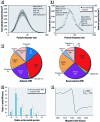Glutamatergic neurons in rodent models respond to nanoscale particulate urban air pollutants in vivo and in vitro
- PMID: 21724521
- PMCID: PMC3222976
- DOI: 10.1289/ehp.1002973
Glutamatergic neurons in rodent models respond to nanoscale particulate urban air pollutants in vivo and in vitro
Abstract
Background: Inhalation of airborne particulate matter (PM) derived from urban traffic is associated with pathology in the arteries, heart, and lung; effects on brain are also indicated but are less documented.
Objective: We evaluated rodent brain responses to urban nanoscale (< 200 nm) PM (nPM).
Methods: Ambient nPM collected near an urban freeway was transferred to aqueous suspension and reaerosolized for 10-week inhalation exposure of mice or directly applied to rat brain cell cultures.
Results: Free radicals were detected by electron paramagnetic resonance in the nPM 30 days after initial collection. Chronic inhalation of reaerosolized nPM altered selected neuronal and glial activities in mice. The neuronal glutamate receptor subunit (GluA1) was decreased in hippocampus, whereas glia were activated and inflammatory cytokines were induced [interleukin-1α (IL-1α), tumor necrosis factor-α (TNFα)] in cerebral cortex. Two in vitro models showed effects of nPM suspensions within 24-48 hr of exposure that involved glutamatergic functions. In hippocampal slice cultures, nPM increased the neurotoxicity of NMDA (N-methyl-d-aspartic acid), a glutamatergic agonist, which was in turn blocked by the NMDA antagonist AP5 [(2R)-amino-5-phosphonopentanoate]. In embryonic neuron cultures, nPM impaired neurite outgrowth, also blocked by AP5. Induction of IL-1α and TNFα in mixed glia cultures required higher nPM concentrations than did neuronal effects. Because conditioned media from nPM-exposed glia also impaired outgrowth of embryonic neurites, nPM can act indirectly, as well as directly, on neurons in vitro.
Conclusions: nPM can affect embryonic and adult neurons through glutamatergic mechanisms. The interactions of nPM with glutamatergic neuronal functions suggest that cerebral ischemia, which involves glutamatergic excitotoxicity, could be exacerbated by nPM.
Conflict of interest statement
The authors declare they have no actual or potential competing financial interests.
Figures




References
-
- Avila-Costa MR, Colin-Barenque L, Fortoul TI, Machado-Salas P, Espinosa-Villanueva J, Rugerio-Vargas C, et al. Memory deterioration in an oxidative stress model and its correlation with cytological changes on rat hippocampus CA1. Neurosci Lett. 1999;270:107–109. - PubMed
-
- Banks WA, Farr SA, Morley JE. Entry of blood-borne cytokines into the central nervous system: effects on cognitive processes. Neuroimmunomodulation. 2002–2003;10:319–327. - PubMed
Publication types
MeSH terms
Substances
Grants and funding
LinkOut - more resources
Full Text Sources

